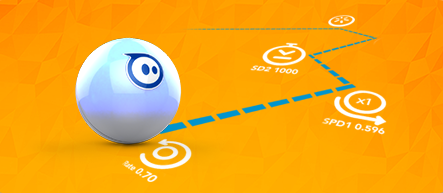Mixed Reality & Sphero Robots
The following text is an extended abstract for a another paper I hope to be presenting at this years ITAG. This time round the paper features the research which I am conducting into the use of mixed reality in conjunction with robotics; in this instance, the robots in question are the most excellent Sphero platform.
Applying Mixed Reality & Sphero Robots to Teach STEM Concepts
In this paper we present the application of Mixed Reality Environments (MRE) in conjunction with Sphero; a commercial off the shelf robotics platform. The result is a framework for educational robotics that is not only affordable for use in both a personal and mainstream educational context, but one which is also robust and safe enough to facilitate this task.
The framework builds upon the existing SPRK (Schools Parents Robotics Kids) program; a curriculum developed by the makers of Sphero to teach STEM (Science, Technology, Engineering and Mathematics) based concepts to children (8-13). At the heart of SPRK is the ethos that play is a powerful teacher. We expand this thinking further by allowing for learning to take place within fun games based MRE that not only foster learning, but also creative problem-solving, teamwork and social interaction.
Sphero is a robotic ball that can be controlled by Bluetooth enabled mobile technologies. It can be instructed to roll at a given speed and direction for a given amount of time. Sphero also provides feedback in the form of variable colour illumination. The robot is unique in that not only can it perform as a controllable robot, it can also be used as a controller. These features make Sphero a perfect fit for STEM education as it allows for the direct mapping of core curriculum concepts such as compound measures; through to more advanced topics like applied geometry and computer programing.
The described framework expands upon Sphero’s existing feature set by facilitating use of the sensors and technologies afforded by the mobile device used to control the robot. The result of which is a self-contained system with advanced methods for interaction and feedback that rival, and in some instances surpass those of more expensive robots. This in turn also allows for a more comprehensive level of curriculum coverage. Our enhancements include: audio, object, symbol, text and speech recognition, inertial sensor based input and navigation and the real-time display of performance metrics.
In a typical lesson, students work in small groups to play out an educational game/scenario. In order to complete each lesson they are required, but not exclusively to:
- Use Sphero to input commands to manipulate the MRE.
- Write computer programs that control how the Sphero rolls and appears.
- Input commands that control how the Sphero rolls and appears.
Each learning game/scenario takes place in a specially designed table top gaming space, the arena. The arena facilitates two primary roles. Foremost it allows for physical objects to be scanned and placed so that they can become elements of the MRE. This allows for real-world objects to become both physical and augmented features with which the Sphero can interact, in both physical and virtual space. Secondly the arena also provides visible metrics that a student can use to solve a task.
We present the design and application of two such learning game/scenarios each formulated to demonstrate the full capability of the described framework.
DOI: 10.13140/RG.2.1.2522.3841
Update, the paper was accepted and here is a link to the presentation.
